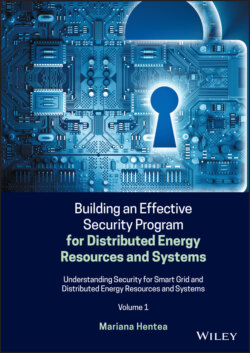Читать книгу Building an Effective Security Program for Distributed Energy Resources and Systems - Mariana Hentea - Страница 19
1.2.2 Smart Grid Definitions
ОглавлениеThe definition of a Smart Grid is broad and encompasses many aspects of electric grid operation and management. A Smart Grid is an improved electrical power grid, a network of transmission lines, substations, transformers, and more that deliver electricity from suppliers to consumers by using two‐way digital technology to communicate with end loads and appliances at industrial, commercial, and residential premises to save energy and reduce capital and operational cost by improving reliability, security, and efficiency of current power grid. The Smart Grid enables greater use of electricity generated from renewable resources.
Smart Grids are typically described as electricity systems complemented by communication networks, monitoring and control systems, smart devices, and end‐user interfaces [OECD 2010], [OECD 2009].
Another Smart Grid definition blends both functions and components [OECD 2012b] and refers to an electricity network that uses digital and other advanced technologies to monitor and manage the transport of electricity from all generation sources to meet the varying electricity demands of end users. Smart Grids coordinate the needs and capabilities of all generators, grid operators, end users, and electricity market stakeholders to operate all parts of the system as efficiently as possible, minimizing costs and environmental impacts while maximizing system reliability, resilience, and stability [IEA 2011].
The Smart Grid is a vision of the future electricity delivery infrastructure that improves network efficiency and resilience while empowering consumers and addressing energy sustainability concerns [Gartner IT].
The SmartGrids Platform was started by the Directorate‐General for Research of the European Commission in 2005 [SmartGrids 2006]. This initiative aims at boosting the competitive situation of the European Union in the field of electricity networks, especially smart power grids. The establishment of a European Technology Platform (ETP) in this field was for the first time suggested by the industrial stakeholders and the research community at the first International Conference on the Integration of Renewable and Distributed Energy Resources [Conference 2004].
Although there is no formal definition of a Smart Grid based on its features proposed in the literature, the Smart Grid may be considered as a power grid in which modern sensors, communication links, and computational power are used to improve the efficiency, stability, and flexibility of the system [Rihan 2011].
The 2006 report of European Commission [SmartGrids 2006] describes the vision of the “Future: operation of system will be shared between central and distributed generators. Control of distributed generators could be aggregated to form microgrids or ‘virtual’ power plants to facilitate their integration both in the physical system and in the market.” Figure 1.4 shows how the concept of SmartGrids works.
Figure 1.4 SmartGrids concept.
Source: [SmartGrids 2006]. © European Communities, 2006.
SmartGrids was a new concept for electricity networks across Europe. The initiative aims to respond to the rising challenges and opportunities, bringing benefits to all users, stakeholders, and companies. Also, the Advisory Council of the technology platform SmartGrids proposed new ways for Europe to move forward on improving the efficiency of the generation, transmission, and distribution of electricity. By using cleaner energy resources (e.g. solar, wind), the SmartGrids aims to benefit the European economy and help improve consumers’ needs.
Figure 1.5 illustrates the vision for the future electricity networks. As presented in the [SmartGrids 2006] report, a proportion of the electricity generated by large conventional plants will be displaced by distributed generation, renewable energy sources, demand response and demand‐side management, and energy storage.
Figure 1.5 Future network vision.
Source: [SmartGrids 2006]. © European Communities, 2006.
Figure 1.6 depicts the layout of the modernized electrical grid with voltages and depictions of electrical lines that are typical of Germany and other European systems. A vision of future developments in Europe is depicted at VISION 2050 site (see [VISION 2050]). More European reference publications are available at [ETIP SNET].
Figure 1.6 General layout of electricity networks.
Source: [ElNet 2014]. Licensed under CC BY 3.0.
The development of Smart Grid in the United States is a result of Title XIII of the Energy Independence and Security Act of 2007 [EISA 2007], which provided legislative support for Department of Energy’s (DOE) Smart Grid activities and reinforced its role in leading and coordinating national grid modernization efforts [Mandates 2007].
The smart power grid delivers electricity from suppliers (e.g. central power plant, distributed generation resources such as wind turbines, microturbines, etc.) to consumers using two‐way digital technology to communicate with end loads and appliances at industrial, commercial, and residential premises to save energy, reduce capital and operational cost by improving efficiency, and increase reliability and transparency. Also, the Smart Grid includes control systems, intelligent devices, and communication networks that keep track of electricity flowing in the grid.
Until this point in time, research on the Smart Grid has revolutionized the way the energy trade will be performed in the near future. The Smart Grid concept challenged the majority of the energy trade stakeholders regarding several aspects of the current setting: infrastructure should be reengineered, and new legislation should be developed, and new business models should be implemented, and so forth. Motivations for Smart Grid developments in the United States are also described in [DOE 2009].
As we have seen in the above definitions, Smart Grid and similar names such as intelligent grid, modern grid, future grid, modernized grid, and so on are all being used to describe a digitized and intelligent version of the current power grid.
